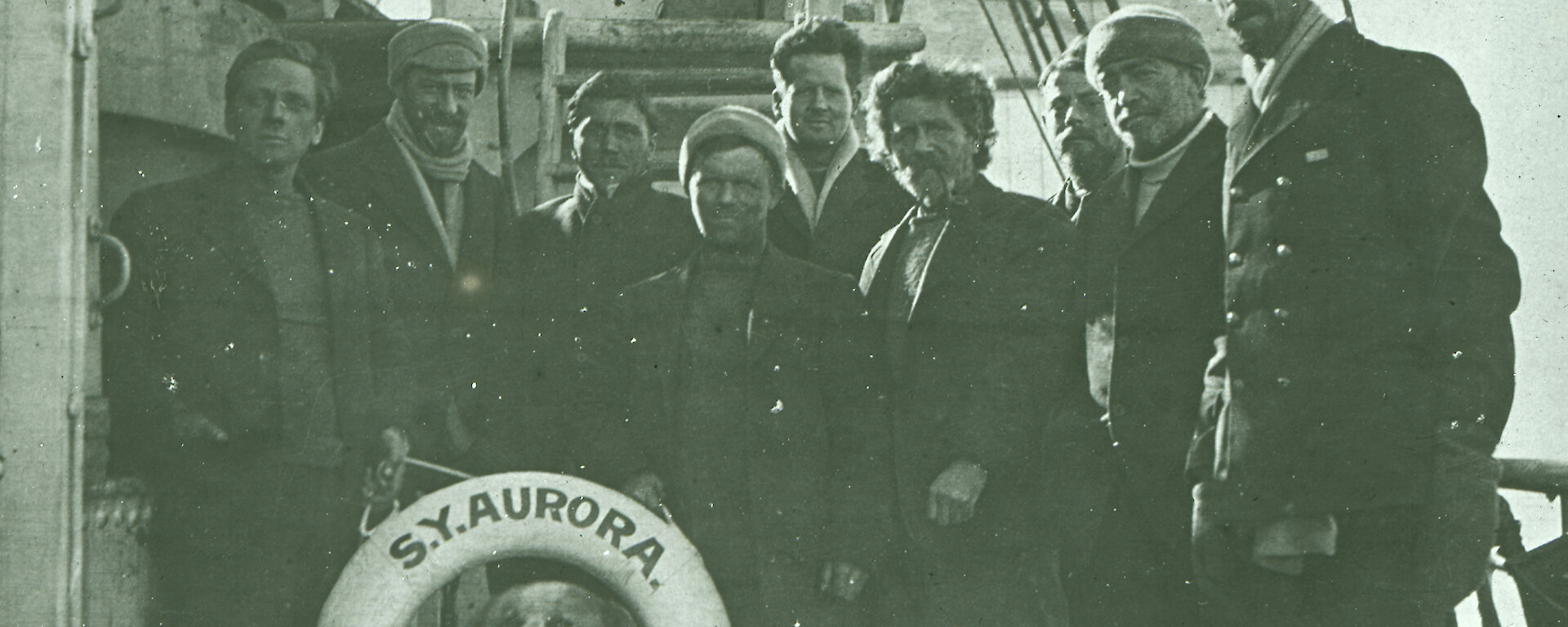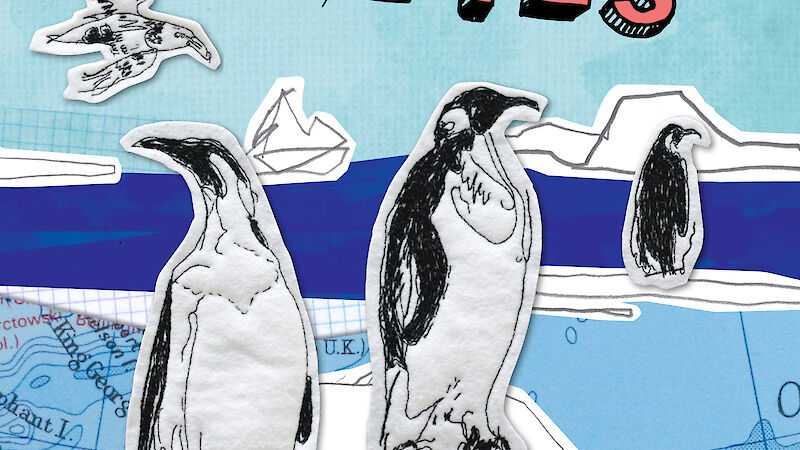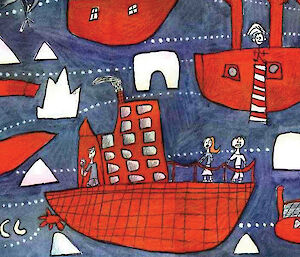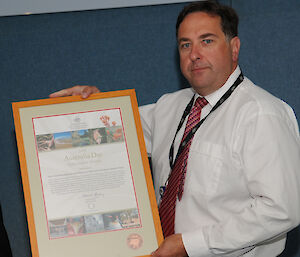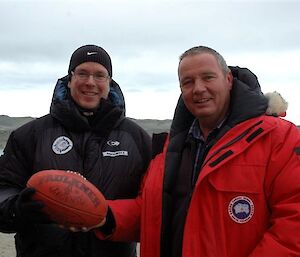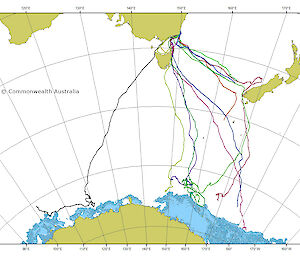Budget 2009
Australia’s leadership in Antarctic science and research has been reinforced with the commitment of an extra $25.2 million over two years for the Australian Antarctic Division, and funding of $11.7 million in 2009–10 to continue the airlink program.
The $36.9 million in funding, announced in May, will underpin our commitment to scientific research, the maintenance of infrastructure at Australia’s three Antarctic stations, Macquarie Island and the Wilkins aerodrome, and continue the government’s commitment to the airlink program.
Polar Eyes: a journey to Antarctica
Two Australian Antarctic Arts Fellows have combined their writing and illustration skills to produce an informative children's book on all things Antarctic. Science writer, Tanya Patrick, of CSIRO Education, and artist Nicholas Hutcheson, visited Antarctica in 2007 and 2008 respectively. While Tanya kept a diary of interviews, observations, photographs and answers to nearly 2000 questions from children across Australia, Nicholas filled his sketchbooks with drawings of penguins, people, icebergs, and much more. Their collaborative 76-page book Polar Eyes covers such diverse topics as wildlife, latitude and longitude, icebergs, tying knots, geophysics and food. It provides lots of hands on learning activities, including building an igloo, rescuing someone from a whiteout, studying animal behaviour, and building a table-top biosphere. A range of interviews with Antarctic scientists are also included, as are answers to questions posed by CSIRO's young Scientriffic magazine readers.
Ross Sea Party photographs online
”Just about the wildest looking gang of men that I have ever seen in my life. Smoke-bleared eyes looked out from grey haggard faces; their hair was matted and uncut; their beards were impregnated with soot and grease.” John King Davis.
This is how the seven survivors of the Ross Sea Party appeared to Davis, commander of the ship that rescued them in 1917. The men had spent more than two years marooned in Antarctica, laying supply deposits for Ernest Shackleton's Imperial Trans-Antarctic Expedition of 1914; an expedition that would never arrive.
The party’s epic sledging journeys encompassed 169 days. One member of the party, the Victorian (Andrew) Keith Jack, kept a detailed diary and took many striking photographs, which are housed at the State Library of Victoria.
The Ross Sea Party account, the Diaries of Keith Jack, and Ross Sea Party photographs, can now be viewed in the Victorian Stories section of the Culture Victoria website. The website tells the stories of people who have lived and worked in Victoria, and the events that have shaped the lives of Victorians and Australians. It was created through the Victorian Cultural Network — a collaborative project between the Australian Centre for Moving Image, Museum Victoria, National Gallery of Victoria, State Library of Victoria, and The Arts Centre.
Andrew McConville (State Library of Victoria) and Eleanor Whitworth (Arts Victoria).
Parliament House Exhibition
Antarctic Art: an exhibition by children, for children, featured at Parliament House in May and June. The exhibition showcased work done by the children from the University of Melbourne's Early Learning Centre, and a number of Australian Antarctic Arts Fellows who produced work for, or with, children. During the International Polar Year (IPY), the children of the Early Learning Centre studied Antarctica with the help of Casey Station Leader, Bob Jones. Their project, Antarctica — an icy land of secrets, received a Regione Lazio Award for its contribution to the IPY.
First Expedition Medicine Course for Australia
The first expedition medicine course for Australia has been developed by General Practice Training Tasmania in consultation with the Australian Antarctic Division’s Polar Medicine Unit.
The Special Skills Post in Expedition Medicine aims to provide General Practice registrars with a comprehensive grounding in expedition medicine through a six month course involving travel medicine, general practice, emergency medicine, a self-guided workbook and an eight day field trip.
Course participants will have access to the Polar Medicine Unit staff and resources. The course is available as an optional part of general practice training in Tasmania. General Practice Training Tasmania and the Polar Medicine Unit are now exploring options for a certificate/diploma/masters program.
Australia Day Awards
This year's Australia Day Award was presented to the Australian Antarctic Division's Crisis Management and Recovery Team and the Davis Station Team in recognition of the extraordinary individual and collective efforts of people across the whole of the Antarctic Division, who were involved in the successful care and evacuation of an injured expeditioner from Davis station in October/November last year. The Division's Chief Medical Officer, Dr Jeff Ayton (pictured), accepted the award on behalf of those involved.
Southern Ocean Sentinel Workshop
A system for measuring climate change impacts in the Southern Ocean was the subject of an international scientific workshop convened in Hobart in April. The participants summarised the state of knowledge on observed and potential climate change impacts on Southern Ocean marine biodiversity, and considered the scientific and technological research required to establish a Southern Ocean Sentinel monitoring program that would signal the magnitudes and rates of change in Southern Ocean marine ecosystems, caused by climate change. They concluded that an international program to develop a system for predicting future impacts, including associated field monitoring, was feasible, and would contribute to established international climate programs. Collaborative links between Australian and international scientists and scientific programs are now being pursued to establish a Southern Ocean Sentinel.
Prince Albert II visits Davis
His Serene Highness Prince Albert II of Monaco visited Davis station in January as part of a month-long expedition to learn about the impact of climate change in Antarctica.
Prince Albert's trip took in 26 scientific hot spots around the continent and followed a similar trip to the North Pole in 2006. Last May, Monaco became the 47th state signatory to the Antarctic Treaty, which regulates human activities on the continent.
During his time at Davis the Prince was treated to a science and station tour, visited nearby rookeries and icebergs and spent an evening mixing with expeditioners and playing pool.
Kids Antarctic Art Exhibition
Australian Antarctic Arts Fellow, Alison Lester, whose artwork has appeared in various issues of this magazine, has been on the exhibition trail with Kids Antarctic Art. Since the exhibition was opened in Hobart in 2007, it has had three showings in Melbourne, one in Brisbane and is scheduled for exhibition in Port Macquarie and Tokyo in 2009.
Whale tags track bigger picture
Scientists at the Australian Antarctic Division have tracked the path of humpback whales, from the Australian coast to their feeding grounds near the Antarctic continent, for the first time.
Sixteen whales were satellite tagged near Eden in New South Wales, last October, and their route tracked for almost six months over a distance of some 4000km. The results showed that whales from Australia’s east coast disperse more widely than previously thought, and outside the area traditionally identified for this population by the International Whaling Commission.
The study, led by the Australian Marine Mammal Centre Director, Dr Nick Gales, suggests the whales spend more time feeding in temperate waters than previously thought. These areas include east of Flinders Island, off northeast Tasmania, and west of Fiordland, New Zealand.
'This is the first study to show migration through Bass Strait and down Tasmania’s west coast,' Dr Gales said.
'These tags will provide important information on the feeding distribution and behaviour of humpback whales in Antarctica and the relationship between their food source — krill — and retracting sea ice during the summer melt.'
View an animation of the whales’ tracks

